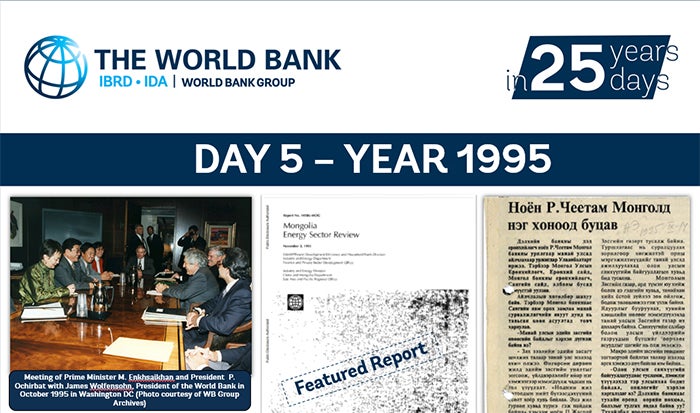
Growth picked up to 6.4% in 1995, but it was a short-lived acceleration—it would be another eight years before Mongolia reached that level of growth again. The World Bank/IDA’s first ever Country Assistance Strategy (CAS) for Mongolia noted that, as painful as the first half of the 1990s had been for Mongolia, it was not as bad as in the countries of the former Soviet Union. Only the Baltic countries had growth resume by 1994. The CAS attributed Mongolia’s turnaround to five factors: strong monetary, fiscal and exchange rate policies to achieve macroeconomic stabilization; an early privatization program which opened the door for a private sector supply response; prompt and continued assistance of the international community; political stability and progress on institutional reforms, including the adoption of several new laws to support the new market-oriented economy; and government commitment: “When controversial decisions need to be taken, reform-oriented views have prevailed within the Cabinet and Parliament. The Government, and society at large, are aware that a return to the past is impossible and emphasize that a market-oriented economy based on democratic principles is central to their development philosophy.”
The CAS emphasized, however, that important challenges lay ahead. Even with relatively low levels of debt, the vulnerable balance of payments position meant that Mongolia “will continue to require grant and concessional assistance for the foreseeable future. Mongolia is unlikely to be sufficiently creditworthy to tap commercial sources of finance in the medium term.” Mongolia’s first CAS focused on the need to stabilize the economy, accelerate the transition to a market economy through private sector development, protect vulnerable groups most affected by the transition, remove infrastructural bottlenecks, and protect the environment.
The previous year the Government of Mongolia had launched a comprehensive National Poverty Alleviation Program (PAP), prepared together with UNDP, aimed at reducing poverty from 26 percent of the population in 1994 to 10 percent by the year 2000. A series of meetings of donors had strongly endorsed the Government’s plans, but financing was needed to implement them. The Poverty Alleviation for Vulnerable Groups project supported the most urgent aspects of the PAP aimed at poverty alleviation among groups particularly vulnerable to the social cost of adjustment. The IDA project drew on project preparation financing by the Japanese Policy and Human Resources Development (PHRD) Fund.
The project sought to mitigate the adverse effects of Mongolia's economic transition on the poor segments of the vulnerable groups, to contribute to the development of the institutional framework for implementing and coordinating the PAP, and to facilitate community participation. This first donor-assisted project to be processed through the PAP framework focused on income generation for the poor (and absolute poor, in particular), raising enrollment in basic education; reducing maternal and other mortality and morbidity; and providing assistance to handicapped and mentally retarded children and disabled persons.

A deeper look was given to the energy sector, which had tottered along in near crisis for years. As 1995’s Energy Sector Review noted, “Chronic reliability problems in power and heat supply in one of the world's coldest regions forced policy-makers and external donors to invest in short-term remedies to maintain energy supply. These measures, plus targeted donor assistance, averted a collapse of energy supply but much needed maintenance, especially in the coal-heat-power delivery system, was deferred and decapitalization of the energy sector increased as the overall system deteriorated.”
The Energy Sector Review identified a set of policy and investment priorities needed “to increase reliability and security of energy supply while minimizing Government financial transfers to the sector.” It also highlighted the importance of examining renewable energy alternatives, including hydro, solar, geothermal, and wind power.
The year 1995 was also the year that the World Bank Group got a new president, James D. Wolfensohn. And it was the year that Mongolia’s first popularly elected president, P. Ochirbat, visited him at the World Bank headquarters in Washington, DC.
Next we look at 1996, taking stock of the profile of the poor and the state of state enterprises.
Prepared in collaboration with Ts. Gerelgua.
(Please follow our 25 years in 25 days journey here and on twitter with the hashtag #WBG_Mongolia25th)


Join the Conversation